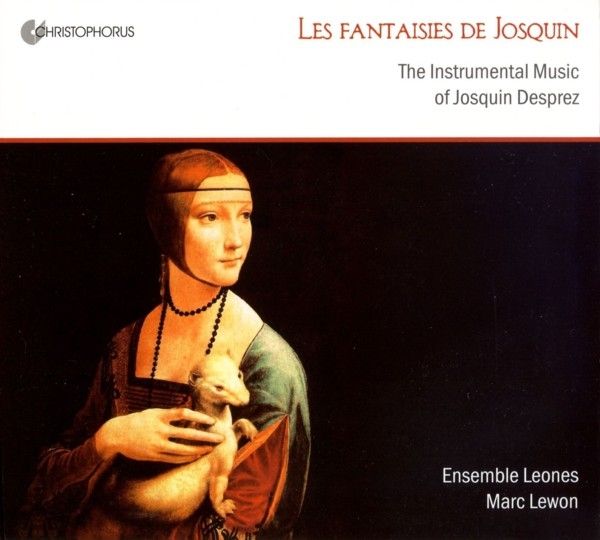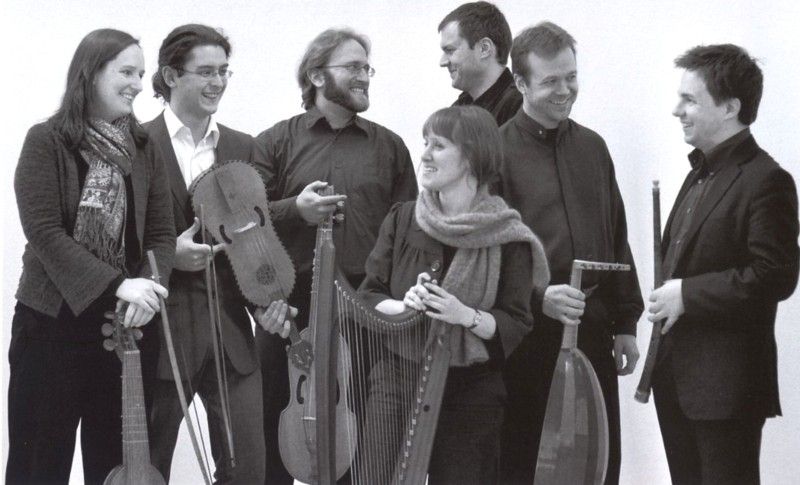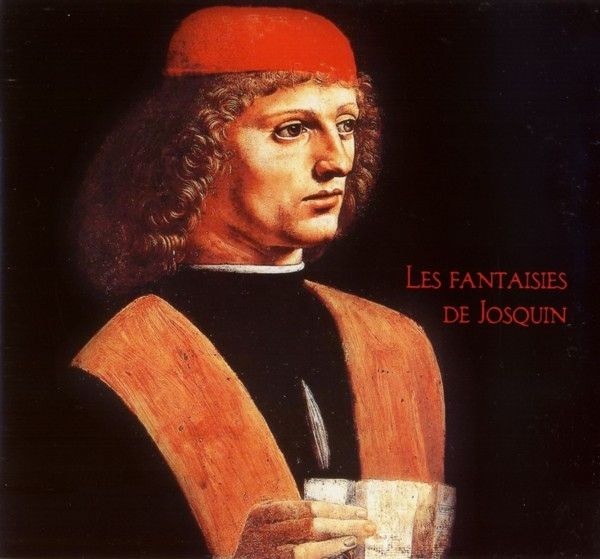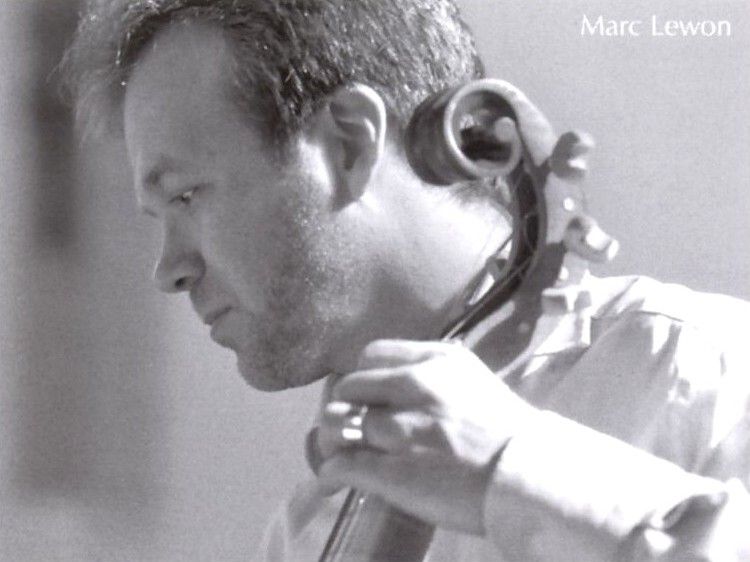Les fantaisies de Josquin / Ensemble Leones
The Instrumental Music of Josquin Desprez

medieval.org
christophorus-records
leones.de
Christophorus 77348
2011
1. Ile fantazies de Joskin [3:07]
JOSQUIN Desprez (c. 1450-1521) / Intavolierung: Marc Lewon
2. La plus de plus à 3 [1:53]
JOSQUIN
3. [ohne Titel] à 3 [2:15]
JOSQUIN
4. De tous biens plaine [1:31]
Monodie, anonyme
5. De tous biens à 3 [2:09]
JOSQUIN
6. De tous biens à 3 [1:12]
anonyme
7. De tous biens plaine à 4 [1:13]
JOSQUIN
8. De tous biens à 4 [1:19]
de PLANQUARD, 15.Jh.
9. Ach hülff mich leid a 4 [7:58]
JOSQUIN / Adam von FULDA, Text und Bassusmelodie
10. La spagna à 3 [2:42]
anonyme
11. La spagna à 5 [2:47]
JOSQUIN
12. [ohne Titel] à 4 [3:05]
JOSQUIN
13. Fortuna desperata [1:45]
Francesco SPINACINO (2. Hälfte 16.Jh.-nach 1507) / JOSQUIN
14. Fortuna desperata à 3 [1:09]
JOSQUIN
15. Fortuna desperata à 4 [1:15]
anonyme
16. Une musque de Biscaye à 4 [2:04]
JOSQUIN
17. Une mousse de Bisquaye [2:16]
anonyme
18. Je sey bien dire à 4 [1:22]
JOSQUIN
19. La bernardina [1:27]
Francesco SPINACINO / JOSQUIN
20. A l'eure que je vous p.x. à 4 [1:07]
JOSQUIN
21. Helas madame à 3 [3:41]
JOSQUIN
22. Si je perdoys mon amy [2:32]
Monodie, anonyme / Begleitung: Baptiste Romain
23. Si j'ay perdu mon amy à 3 [2:18]
JOSQUIN
24. Si j'ay perdu mon amy à 4 [0:57]
JOSQUIN
25. L'homme armé [0:37]
Monodie, anonyme
26. L'homme armé à 4 [3:05]
JOSQUIN / Improvisierte Diminutionen: Leones
27. Cela sans plus à 4 [1:25]
JOSQUIN
28. A Dieu, mes amours [0:45]
Monodie, anonyme / Begleitung: Marc Lewon
29. Adieu, mes amours à 4 [2:02]
JOSQUIN / Bonifacius AMERBACH, 1495-1562
30. Adieu, mes amours à 4 [4:24]
JOSQUIN
31. Sei gelobt, du Baum [2:55]
Arvo PÄRT, *1935
32. Ile fantazies de Joskin à 3 [2:48]
JOSQUIN

Ensemble Leones
Marc Lewon
Raitis Grigalis, Bariton
Baptiste Romain, Renaissancevioline, Vielle
Elizabeth Rumsey, Viola d'arco, Renaissancegambe
Uri Smilansky, Viola d'arco
Kirsty Whatley, Harfe
Gawain Glenton, Zink
Marc Lewon, Plektrumlaute, Renaissancelaute, Quinterne, Viola d'arco
Gäste:
Noëlle-Anne Darbellay — Violine
Martin Wyss — Kontrabass
Recording: 22.-25.2.2010, Heilig Kreuz Kirche Binningen
(CH)
Recording producer & digital editing: Charles
Suter
Recording technician: Urs Dürr
Coproduction with DRS 2

De Flandria
von Marc Lewon
Aus dem späten 15. Jahrhundert ist mit einem Male eine ganze Flut
von Instrumentalstücken überliefert. Was bis dato keine
Spuren hinterlassen hatte, weil es die Spieler selbst und Schriftlos
ausgeführt hatten, erklärten die führenden,
„burgundischen" Komponisten nun zur Chefsache: neben der
Vokalmusik entwickelte sich die Instrumentalkomposition in Flandern zum
seriösen Betätigungsfeld. Dadurch wurde das Repertoire
eigener Bearbeitungen und Improvisationen der Instrumentalisten um neue
Gattungen erweitert, die sich hauptsächlich aus der Vokalmusik
rekrutierten: Zur stilistischen oder duobesetzten Tanz- und
Diminuitionsmusik gesellten sich Chansonbearbeitungen und ganze
„instrumentale Motetten" für Ensembles. Deren Struktur
konnte nun nicht mehr von der Interpretation eines vorgegebenen Textes
ausgehen, so dass sich eine genuin musikalische Rhetorik entwickelte.
Zwar kann die Überlieferung „textloser Musik" nicht mit
„Instrumentalmusik" gleichgesetzt werden, zahlreiche Hinweise
aber deuten auf eine weitverbreitete instrumentale Verwendung der Werke
hin. Einem der bedeutendsten Komponisten dieser ersten instrumentalen
Blüte ist die Debüt-CD des Ensemble Leones gewidmet: Josquin
Desprez mag sich als Komponist geistlicher Vokalmusik seine
größten Meriten verdient haben, als bislang
vernachlässigter Komponist weltlicher Instrumentalmusik soll er
jedoch mit dieser Einspielung gebührende Würdigung erfahren.
Die neue Art der instrumentalen Ensemblemusik eignet sich besonders
für homogene Besetzungen, die eine optimale klangliche
Verschmelzung gewährleisten. Von daher besteht die Kernbesetzung
für die vorliegende Aufnahme einerseits aus dem drei- bis
vierstimmigen Streicherensemble mit Viola d'arco, Vielle,
Renaissancevioline und -gambe, andererseits aus einem Zupfduo mit Laute
oder Quinterne und Harfe.
Zwei spezielle Klangfarben, die bislang wenig Beachtung bei der
neuzeitlichen Interpretation von Musik der Frührenaissance
gespielt haben, erhalten in dieser Einspielung besondere Gewichtung:
Zum einen wird die Harfe vorwiegend mit Schnarrhaken eingesetzt —
d.h. mit kleinen Stiften, die so an die Saiten geführt werden,
dass sie beim Anreißen einen Schnarrton erzeugen. Im 15. und 16.
Jahrhundert wurden Harfen generell mit dieser Klangfarbe gespielt, die
den Vorteil hat, sich im Ensemble zu behaupten und sich obendrein mit
Streichern und der plektrumgeschlagenen Laute hervorragend zu mischen.
Zum anderen ist der Zink, der mit Sicherheit seit spätestens dem
15. Jahrhundert eingesetzt wurde, viel zu selten mit seinem
wunderschönen Klang in der frühen Musik zu hören. Die
vorliegende Aufnahme sei für beide Klangfarben Anreiz und Argument.
Da instrumentale Werke dieser Frühphase häufig wie
Gelegenheitsstücke oder kleine musikalische Einfälle wirken
und von daher in der Regel sehr kurz sind, bot es sich für die
Einspielung an, sie zu größeren Einheiten zusammenzufassen.
In 14 Blöcken sind die Stücke auf der CD so geordnet, dass
sie innerhalb der dadurch entstandenen „Suiten" in sich
geschlossene Bögen darstellen und in ihrer Reihung über die
Aufnahme hinweg eine Entwicklung erfahren. Dabei wurden Josquins
Bearbeitungen in einen Kontext gestellt, der sie musikalisch
erläutert: Bei vielen seiner Stücke war ein schlichtes,
einstimmiges (Volks-)Lied Vorlage für die mehrstimmige
Ausarbeitung durch den Komponisten. Diese Vorlage wird hier von einem
Sänger mit schlichter Begleitung den instrumentalen Bearbeitungen
vorangestellt, so dass im Verlaufe der Suiten gewissermaßen
jeweils ein „Thema mit Variationen" zu Gehör gebracht wird.

Neue
Musik für altes Holz
von Marc Lewon
Als 1962 ein Stück Weißtannenholz auf einem Schweizer
Weingut ausgegraben wird, ahnt noch niemand, dass der kleine Baumstamm
seit dem Jahre 317 vor Christus dort verschüttet liegt. 2001 wird
das über 2000 Jahre alte Holz analysiert und sein hohes Alter
stellt sich heraus. Es wird entschieden, aus dem Fund Deckenholz
für zwei Instrumente zu gewinnen —eine Barockvioline und
eine Quinterne. Als über Vermittlung der estnischen Dichterin
Viivi Luik der Komponist Arvo Pärt davon erfährt,
verkündet dieser, ein Stück für die Instrumente aus
uraltem Holz schreiben zu wollen. Adrian Steger, der die Quinterne
für die Instrumentensammlung Willisau bei Richard Earle (Basel) in
Auftrag gegeben hatte, zog mich hinzu, den Bau des Instruments beratend
zu begleiten, das fertige Instrument zu besaiten und einzuspielen. Auch
hatte ich die Ehre, Arvo Pärt die Verwendung und Funktionsweise
der Quinterne zu erläutern. Und somit schließt sich mit
dieser Ersteinspielung der Komposition Sei gelobt, du Baum ein sehr
persönlicher Kreis, der die alten Instrumente und Klänge des
Ensembles eng mit der Gegenwart verknüpft. Ich danke Arvo
Pärt für das Vertrauen, die Ersteinspielung vorgenommen haben
zu dürfen.

Les
fantaisies de Josquin
by David Fallows
Ile fantazies de Joskin is one of the oddest known titles
for a piece of music in the fifteenth century. The word 'fantasia' had
already appeared in humanist writings about music and was to become
very common in the middle years of the sixteenth century for abstract
instrumental pieces. But this one looks like a polyphonic song —
a strange one, to be sure, with its unusual textures and wayward lines,
but in every other way keeping to the formal design one would expect
for a perfectly normal rondeau setting. Unfortunately the only source
for Ile fantazies — a marvellously elegant manuscript prepared
for Isabella d'Este at the court of Ferrara — has no full texts
for its music: just the opening words or the title of each piece,
entered in an extremely elegant and expensive script called littera
antigua alla romana with golden initials on every page but written
with a lofty disdain for the details of the texts (or the names of the
composers: he spells the simple word Josquin in six different ways).
From what we know of French prosody at the time, it is almost
impossible that the missing text for this particular piece opened 'Ile
fantazies'; so we must content ourselves with the mysterious title and
simply allow the music to beguile us. That the piece begins and ends
our CD is a hint at just one of the many mysteries that surround
Josquin Desprez and his music.
Over the past ten years those mysteries have changed. Formerly Josquin
was believed to have
been born around 1440; now it is agreed that he was at least ten years
younger, closer to the age of Isaac and Obrecht. It seems, too, that he
was a choirboy in Cambrai rather than, as earlier thought, St-Quentin,
which places him firmly in the circle of the great composers of the
previous generation, particularly Binchois, Du Fay and Ockeghem. As a
result, his early career has also changed: the old view was that he was
in Milan from the age of about twenty until he was almost forty; now it
looks as though he joined the Provençal court of 'good' King
René of Anjou in his early twenties, moving to that of King
Louis XI of France five years later, and that by his mid-thirties he
had served yet a third king, Matthias Corvinus of Hungary. It remains
true that very soon after 1500 he was fully accepted as the leading
composer of his day, as witnessed by the set of three collections of
his masses published in Venice by Ottaviano Petrucci, the first of them
going through six editions before Josquin died in 1521: no other
composer of those years was honoured by more than one volume devoted to
his music until Carpentras (who paid for them himself), and no other
book of music achieved so many reprints until Arcadelt's first book of
four-voice madrigals almost forty years later. But for the present CD
the important change is that his early career was in French royal
courts, not in Italy.
So even though Ile fantazies de Josquin probably originated as
a texted song in the later 1470s, when Josquin was with René of
Anjou, its appearance in Isabella d'Este's manuscript was certainly
intended for use as a purely instrumental piece. One of the main
innovations in music of the last quarter of the fifteenth century is
the rise in Italy of purely instrumental ensembles to perform music
that could have been written for voices. The same is the case with La
plus des plus, first found in the earliest printed collection
of music, Petrucci's Odhecaton (Venice, 1501), but almost
certainly also written during Josquin's time with René: here we
do actually have a possible text from a poetry manuscript of the time,
but again the music's appearance in its five surviving sources is
always plainly intended as an instrumental piece. For the next piece on
the CD we have no text at all, but its form clearly states that it is a
vocal piece of the years around 1500 based on a popular melody (yet to
be identified).
Another development in the last quarter of the fifteenth century
consisted of taking one or two lines from an existing masterpiece and
adding further lines. The most often used work for this was the rondeau
De tous biens plaine, by the Burgundian court composer
Hayne van Ghizeghem: at the latest count there were 54 arrangements of
that song. The two versions credited to Josquin both use canonic
techniques: that in three voices has the two lower voices in canon at
the fifth; that in four voices has two bass lines in unison canon at
the bizarre time-interval of only a minima.
This group of pieces on the CD ends with another setting of De tous
biens plaine that does exactly the same, with a close unison canon
in the bass; but it is credited to the otherwise unknown 'De
Planquard'. That obviously raises intriguing questions: how many
listeners can tell the difference in quality between the most famous
composer of the Renaissance and an entirely unknown figure? does the
difference matter? and could it be that De Planquard is just another
name for Josquin?
With Ach hillff mich leid we face a similar set of
questions. The piece takes its melody from a famous song by Adam von
Fulda (d. 1505), puts it in the bass register and constructs a new set
of counterpoints above it, beginning in three voices and then moving
into four voices for the Abgesang. The sources credit it to
four different composers: Pierre de la Rue (d.1518), Noel Bauldeweyn
(d. after 1513), Hans Buchner (1483-1538) and Josquin. From the first
moment, the music sounds German rather than Franco-Flemish, but that
would rule out La Rue and Bauldeweyn as possible composers as well as
Josquin. Moreover, all those ascriptions were done by copyists about
whom we know a fair amount, and all of them were intelligent enough to
recognize that this piece is in the Germanic style. All of them almost
certainly also knew enough to see that it fits very oddly indeed with
the other known works of Josquin and La Rue. The Josquin ascription is
in the keyboard manuscript of Fridolin Sicher, who first of all
credited the piece to 'Maister hansen' (Buchner) and then crossed that
out to add 'Josquin composuit'. Five considerations combine to suggest
that Sicher was right. First, he had studied with Buchner and therefore
had access to the best information about him. Second, there is in fact
a setting by Buchner of Ach hülff mich leid, reliably
credited to him in two other keyboard manuscripts of the time: Sicher
(or the writer of his exemplar) could easily have confused the two for
a moment. Third, Sicher — from whom we have two excellent music
manuscripts — was not inclined to be profligate with ascriptions:
unlike many other copyists of the time, he was perfectly happy to leave
pieces anonymous, though in this case he chose otherwise. Fourth, the
actual decision to cross out one ascription and substitute another is
extremely rare in manuscripts of the time and suggests positive
knowledge. Fifth, Sicher certainly knew that an ascription of the piece
to Josquin was counterintuitive, but he went ahead. Many listeners
today may think they know better; but by ignoring this piece we risk
losing a dimension of Josquin's output.
And that is another way in which the mystery of Josquin has changed in
recent years. It has always been clear that many spurious works were
circulating under Josquin's name: the difficulty was how to identify
them. Previously critics relied on a deep-seated musical judgment.
Today, most agree that this judgment (often based on a knowledge of now
discredited works such as Absalom fili mi and Missa Da pacem)
is easily misled. A harder look at the nature of the documentation
seems important. It may be worth adding that, of all the thirteen later
settings of Adam von Fulda's Ach hülff mich leid, only
this one survives today in more than two sources: it has no fewer than
nine sources. That obviously cannot stand as evidence that the
arrangement is by the prince of musicians (as Egidius Tschudi dubbed
him); but it at least shows that many musicians of the early sixteenth
century thought the piece worthy of serious attention — and
perhaps we should consider thinking likewise.
La spagna is a dance-tune with a history that goes back
to at least the middle of the fifteenth century and survives in many
different arrangements (Otto Gombosi listed 361 of them). Some of them
look a little as though they could have been improvised, but many
others are plainly worked with the most careful technical control. The
three-voice setting in Petrucci's Canti C (1504), also found in
two lute intabulations, is one of the most impressive of these: like so
much of the best music of its time, it survives anonymously.
As concerns the five-voice La spagna, though, we have more or
less the opposite situation. It survives in no fewer than seven
sources, all but two of which credit it to Josquin. But no recent
writer has accepted his authorship, for four main reasons. First, the
earliest known source for the work is a German print dated 1537, long
after his death, and the mid-century German prints are the main
locations of Josquin spuria, apparently added to bolster sales. Second,
the other ascribed sources are stemnnatically descended from that print
and therefore have no independent value. Third, the thick textures of
the setting are quite unlike what we otherwise know of Josquin's music.
Fourth, the setting is a stylistic twin of a setting of the melody T'Andemaken
op den Rijn credited to the famous music-copyist and political
agent Petrus Alamire, who therefore seems a more likely composer of the
La spagna setting. Even so, as in the case of Ach hülff
mich laid, there is a risk that we may lose a dimension of
Josquin's art by too quickly dismissing anything that is at first
glance unlike his more famous works.
The same is true of the lovely textless piece that survives only in a
manuscript in Zwickau dated 1531. At first blush it sounds as though it
is by the composer of Innsbruck, ich muss dich lassen (whose
identity is also now in question), but that must have been obvious also
to any listener in 1531 and therefore to whoever wrote Josquin's name
on the music. Unlike the case of the five-voice La spagna, this
cannot have been for any financial benefit: the copyist was just adding
information that he thought would interest or enlighten his reader.
Perhaps we can take it in the same spirit.

Fortuna desperata was one of the most popular three-voice
songs of the 1460s, sometimes credited to Busnoys but more likely to be
by an obscure Florentine singer called Felice di Giovanni Martini. We
hear it first in a florid arrangement by Francesco Spinacino, then in a
version credited to Josquin (in the Segovia choirbook, which is hardly
a trustworthy source for Josquin) and finally in an anonymous version
from the Bologna manuscript Q18.
Une musque de Biscaye tells the story of a knight
attempting to seduce a shepherdess from Biscaye, whose language he
cannot understand. Here Josquin's music takes the popular tune (known
from several other settings, among them four mass cycles) and treats it
in canon at the fourth between the two upper voices; and for a short
while all four voices are in pure canon. In Je sey bien dire
he takes what must be another popular tune (though this one is not
otherwise known), puts it in the tenor in the middle of the texture and
builds around it a counterpoint of truly bewildering complexity and
rhythmical intricacy.
With La bernardina we encounter a piece a little like Ile
fantazies de Joskin and La plus de plus but with the
crucial difference that it can certainly never have carried text. That
is to say that its form shows none of the articulation points that
characterize any setting of poetry: this is pure musical fantasy.
So is the next piece, A l'heure que je vous p.x., as it
is labelled in its only source. What on earth the title could mean,
nobody has yet attempted to explain. But the music is clear enough,
built within two outer voices that are in pure canon at the unusual
interval of a ninth. Technically, this is not as hard as it may sound,
not least because Josquin runs those canonic voices essentially in
parallel tenths throughout, though the result has a dazzling range of
musical ideas.
But in terms of producing unexpected and strange music, there is
perhaps nothing to match Helas madame: it looks like a
song; and its lines work precisely like those of a song; but the
extended musical form is quite unlike that of any other secular song in
the fifteenth century. Once again, we have no text in any of the four
fifteenth-century sources that contain it; and it looks very much in
this case as though the strange form was driven by a poem; but it is
very hard indeed to imagine what form that poem could have had, and it
is impossible to find a poem among the literary sources of the time
that could match this music. Once again, then, Josquin presents us with
an insoluble mystery.
Si J'ay perdu mon amy is the kind of tune used many
times by francophone composers of the early sixteenth century. lt tells
the story of a lady who has lost her lover but laments the loss in such
apparently cheerful terms that she is plainly happy to be able to start
again with a new lover. Both the three-voice and the four-voice
settings ascribed to Josquin betray this unmistakable joviality
throughout.
But nobody can guess the mood of Josquin's little setting of the L'homme
armé melody. Two of his most magnificent achievements
are mass cycles on this melody, glittering works that show his
virtuosity and resource at every turn. Here, though, he seems almost to
be resisting show of any kind. Of the various commentators over the
years, Gustave Reese called it 'gay', Richard Taruskin called it 'fun',
Edward Lowinky called it 'singularly unattractive' whereas August
Wilhelm Ambros (1868) called it 'unerquicklich und trocken, zum
Glücke sehr kurz'. In this performance it is treated as a basis
for improvisation.
The next two pieces are among his earliest songs. Cela sans plus
probably began life with a full rondeau text that happens not to have
survived, though its immaculate counterpoints make it work magically as
an instrumental ensemble piece. Adieu mes amours was one
of Josquin's most successful works and the first of his works to
achieve true international fame: it began life as a combinative
chanson, with a full rondeau text in the discantus and a popular song
distributed between the two lowest voices; and then, like so many of
his works, it found its way into the international instrumental
repertory, being printed for the last time in Benedict de Drusina's
lutebook of 1556, some eighty years after it had been composed.







